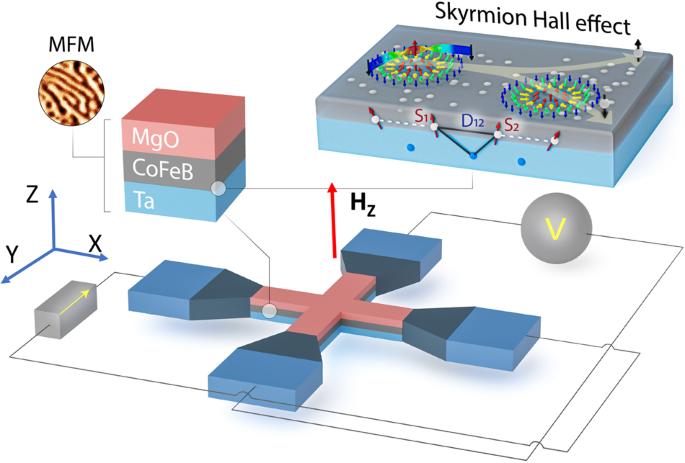Anomalous hall and skyrmion topological hall resistivity in magnetic heterostructures for the neuromorphic computing applications
引用次数: 0
Abstract
Topologically protected spin textures, such as magnetic skyrmions, have shown the potential for high-density data storage and energy-efficient computing applications owing to their particle-like behavior, small size, and low driving current requirements. Evaluating the writing and reading of the skyrmion’s magnetic and electrical characteristics is crucial to implementing these devices. In this paper, we present the magnetic heterostructure Hall bar device and study the anomalous Hall and topological Hall signals in these devices. Using different measurement techniques, we investigate the magnetic and electrical characteristics of the magnetic structure. We measure the skyrmion topological resistivity and the magnetic field at different temperatures. MFM imaging and micromagnetic simulations further explain the anomalous Hall and topological Hall resistivity characteristics at various magnetic fields and temperatures. The study is extended to propose a skyrmion-based synaptic device showing spin-orbit torque-controlled plasticity. The resistance states are read using the anomalous Hall measurement technique. The device integration in a neuromorphic circuit is simulated in a 3-layer feedforward artificial neural network ANN. Based on the proposed synapses, the neural network is trained and tested on the MNIST data set, where a recognition accuracy performance of about 90% is achieved. Considering the nanosecond reading/writing time scale and a good system level performance, these devices exhibit a substantial prospect for energy-efficient neuromorphic computing.

用于神经形态计算应用的磁性异质结构中的反常霍尔和 Skyrmion 拓扑霍尔电阻率
拓扑保护自旋纹理(如磁性天融子)因其类似粒子的行为、小尺寸和低驱动电流要求,已显示出高密度数据存储和节能计算应用的潜力。评估写入和读取 skyrmion 的磁性和电气特性对于实现这些设备至关重要。本文介绍了磁性异质结构霍尔条器件,并研究了这些器件中的反常霍尔和拓扑霍尔信号。利用不同的测量技术,我们研究了磁结构的磁特性和电特性。我们测量了不同温度下的天融拓扑电阻率和磁场。MFM 成像和微磁模拟进一步解释了不同磁场和温度下的反常霍尔和拓扑霍尔电阻率特性。这项研究的延伸提出了一种基于 skyrmion 的突触器件,它显示了自旋轨道转矩控制的可塑性。利用反常霍尔测量技术读取了电阻状态。在 3 层前馈人工神经网络 ANN 中模拟了神经形态电路中的器件集成。根据提出的突触,神经网络在 MNIST 数据集上进行了训练和测试,识别准确率达到约 90%。考虑到纳秒级的读写时间尺度和良好的系统级性能,这些器件展示了高能效神经形态计算的广阔前景。
本文章由计算机程序翻译,如有差异,请以英文原文为准。
求助全文
约1分钟内获得全文
求助全文

 求助内容:
求助内容: 应助结果提醒方式:
应助结果提醒方式:


